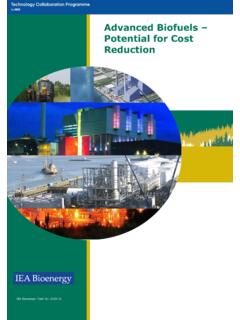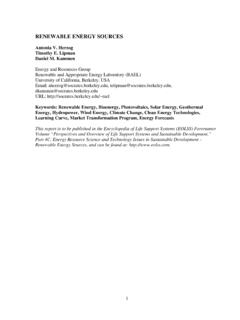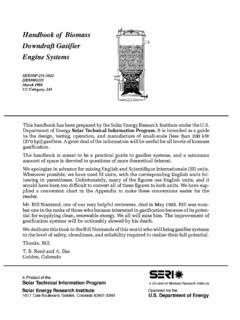Transcription of Hydrogen from biomass gasification - IEA Bioenergy
1 Hydrogen from biomass gasification biomass harvesting, Photo: Bioenergy2020+ IEA Bioenergy : Task 33: December 2018 IEA Bioenergy , also known as the Technology Collaboration Programme (TCP) for a Programme of Research, Development and Demonstration on Bioenergy , functions within a Framework created by the International energy Agency (IEA). Views, findings and publications of IEA Bioenergy do not necessarily represent the views or policies of the IEA Secretariat or of its individual Member countries.
2 Hydrogen from biomass gasification Matthias Binder, Michael Kraussler, Matthias Kuba, and Markus Luisser Edited by Reinhard Rauch Copyright 2018 IEA Bioenergy . All rights Reserved ISBN, 978-1-910154-59-5 Published by IEA Bioenergy Executive Summary Hydrogen will be an important renewable secondary energy carrier for the future. Today, Hydrogen is predominantly produced from fossil fuels. Hydrogen production from biomass via gasification can be an auspicious alternative for future decarbonized applications, which are based on renewable and carbon-dioxide-neutral produced Hydrogen .
3 This study gives an overview of possible ways to produce Hydrogen via biomass gasification . First, an overview of the current market situation is given. Then, Hydrogen production based on biomass gasification is explained. Two different Hydrogen production routes, based on biomass gasification , were investigated in more detail. Hydrogen production was investigated for steam gasification and sorption enhanced reforming. Both routes assessed, appear suitable for Hydrogen production. biomass to Hydrogen efficiencies (LHV based) of up to 69% are achieved and a techno-economic study shows, Hydrogen selling prices of down to EUR kg-1 (or 79 EUR MWh-1).
4 Overall it can be stated, that governmental support and subsidies are necessary for successful implementation of Hydrogen production based on biomass gasification technologies. Especially the first 15 years of the development towards market maturity and stable operation and production are critical and will need political support systems. For evaluating the process chains it can be stated that gas upgrading unit operations, such as WGS, scrubbers and PSA units, are technologically proven and available on the market for similar applications.
5 Furthermore, the feedstock spectrum has to be broadened in the future to increase the flexibility of the process and improve the overall economic feasibility. 1 Content Reasons to produce renewable Hydrogen 4 Overview about markets and applications of renewable Hydrogen 7 SMALL SCALE - Hydrogen FILLING STATIONS 8 MEDIUM SCALE - Hydrogen FOR REFINERIES 11 LARGE SCALE - Hydrogen FOR INDUSTRIAL AREAS 13 Hydrogen PRODUCTION IN THE FUTURE 13 Technology description 16 INDUSTRIAL Hydrogen PRODUCTION 16 biomass gasification 19 Dual fluidized bed gasification technology from TU Wien 22 MILENA gasification technology 25 Heat-pipe reformer technology 28 Sorption
6 Enhanced reforming 31 PRODUCT GAS UPGRADING AND CLEANING 34 Water gas shift 34 Rapeseed oil methyl ester tar scrubber 36 Amine scrubber 37 Catalytic hot gas cleaning for tar reduction 39 Dust filters 41 Further gas cleaning 42 Hydrogen SEPARATION TECHNOLOGIES 42 Pressure swing adsorption 42 Gas permeation through membranes 43 INVESTIGATED Hydrogen PRODUCTION ROUTES 45 Employed unit operations 45 Hydrogen production concept based on dual fluidized bed gasification process chain 48 Hydrogen production concept based on sorption enhanced reforming process chain 53 2 Technology readiness level assessment 57 Techno-economic assessment 60 METHODOLOGY 60 RESULTS AND DISCUSSION 65 Hydrogen production based on dual fluidized bed gasification 65 Hydrogen production based on sorption enhanced reforming process 66 Comparison of results 68 Conclusion and outlook 69 Annex 70 List of Figures 72 List of Tables 74 Nomenclature 75 Bibliography 78 3 Reasons to produce renewable Hydrogen The growing global energy
7 Demand is mostly covered by fossil primary energy sources. Since the beginning of the industrialization, usages and requirements for energy carriers changed according to the state of science and technology. Over time, consumption of fuels has moved from solids such as wood and then coal, followed by a parallel use of liquid crude oil to a, nowadays, also strong increase in the use of natural gas. Disregarding the traditional use of wood, this has le d to a shift from carbon to Hydrogen with respect to the molar ratio of the fuels.
8 This trend of decarbonization could be enhanced by strengthened substitution of the fossil fuels with Hydrogen . (Dunn, 2002; Hefner III, 2002) The Paris Agreement, also referred to as Paris climate accord, is an agreement within the United Nations Framework Convention on Climate Change (UNFCCC), which for the first time brought all nations into a common cause to set ambitious goals for keeping the global temperature rise below 2 C. Despite that the United States of America have left the agreement.
9 Nevertheless, it is the strongest international framework for the development of alternative sustainable technologies so fa r and promotes the application of renewable sources in industrial processes. (Paris Agreement, 2015) Nowadays, Hydrogen is an important intermediate in chemical industry and refineries. The annual production of Hydrogen was around 100 million tonnes in 2014 (50 % captive, 44 % by-product and 6 % merchant production), or 12 EJ on an LHV basis (equivalent of some 2 % of the global primary energy consumption).
10 Renewable Hydrogen is seen as an important secondary energy carrier of the future and could be used directly as fuel and feedstock for further syntheses as well as for the generation and storage of electricity. (Ball and Wietschel, 2009; Liu et al., 2010) Today, 95% of the global Hydrogen production is based on fossil fuels, which is then associated with huge carbon dioxide emissions. A small share of H2 is generated by water electrolysis using electricity. As long as supplied electricity generates carbon dioxide emissions, this does not solve the dilemma of greenhouse gases with a sustainable effect, as electricity is generated using fossil fuels.














